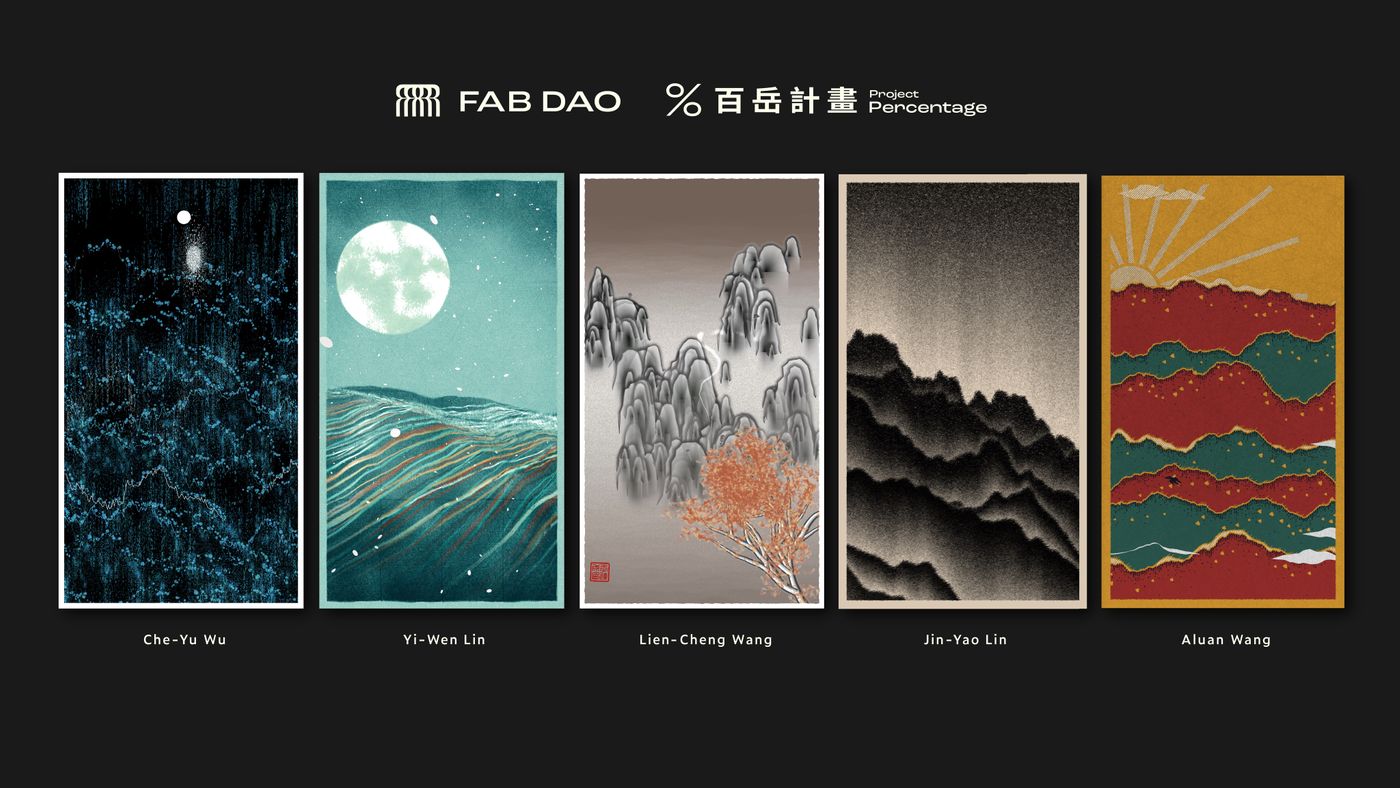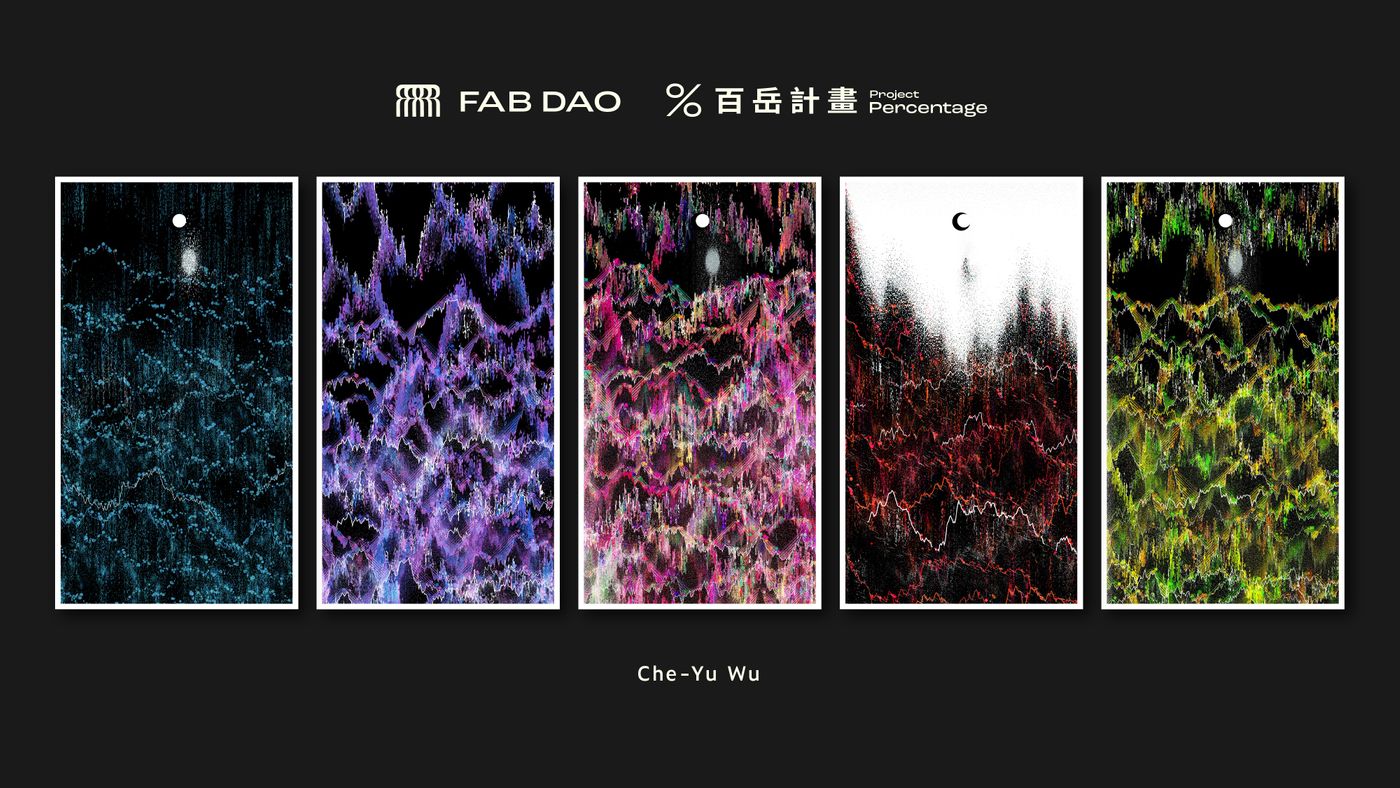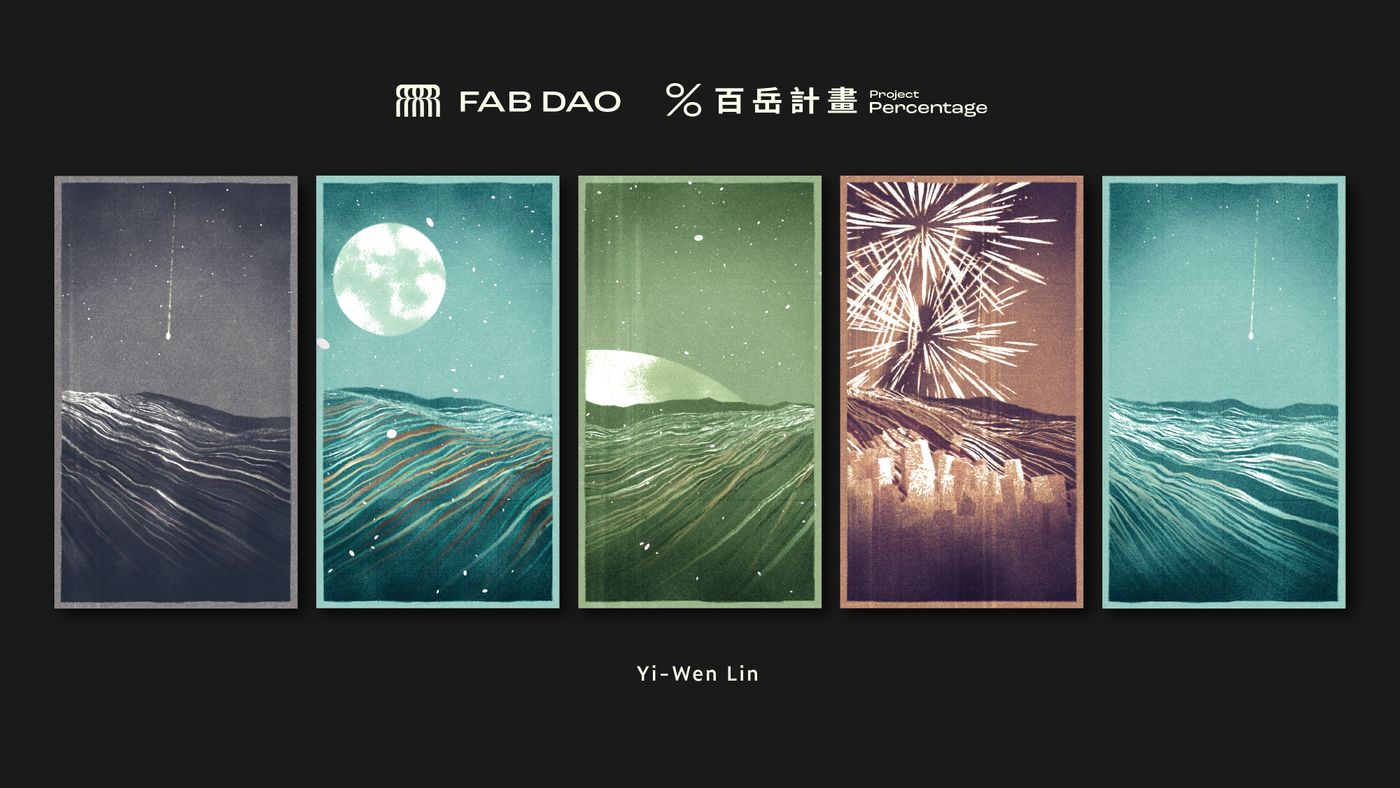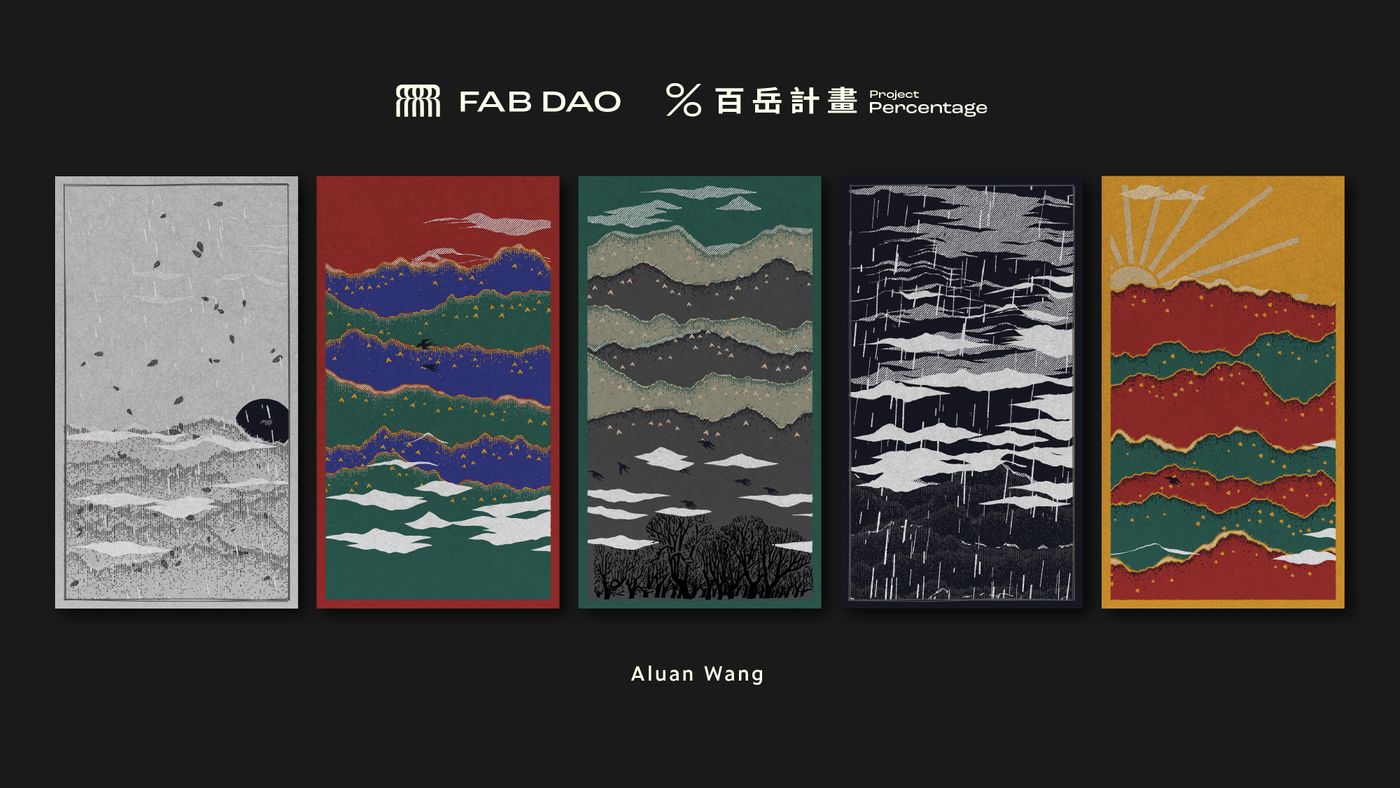Baiyue Project "We want to create generative art that will stand the test of time."
What I want to say about the Baiyue Project is: "We want to create generative art that will stand the test of time."
The Baiyue Project is 10,000 NFTs, a community governance experiment, a generative art exhibition, and a web3 non-profit initiative about Taiwan. It has many aspects.
To put it simply, these 10,000 generative art NFTs were created by five internationally renowned Taiwanese generative artists. One NFT is worth about NT$1,000 (today's exchange rate), and 10 million are collected to become Metaverse public funds. The public funds are not controlled by me, but managed by all collectors to cultivate Taiwan's non-profit ecosystem.
Big, far, ideal.
"Baiyue NFT" can be said to be a donation receipt with voting function, but the artistic value of this receipt itself may be far more than just a receipt.
This article shares the generative art of Baiyue Project and the artists behind it.
We want to create generative art that will stand the test of time.

In the past six months, I have been obsessed with generative art, and I have wandered around the world as a collector and sharer. Therefore, I have made friends that I never knew before. Age and background are not a problem at all. These people are completely new people in the NFT world.
Generative Art has a long history. Humans generate creations through an automated process. The main tools at present are mainly code. Such tools are also called Creative Coding. Due to the birth of NFT, generative art has undergone drastic changes, especially this year, when the world has entered a bear market, the generative art trading market is still operating enthusiastically, and creators and collectors are still communicating and iterating with each other.
What does generative art NFT look like? First, the creator writes a string of code and packs it up and puts it on the shelves. During the casting process, the collector will get a special NFT whose style is similar to the works cast by others, but it is still unique. controlled randomness.
Just because of this concept, Generative Art NFT has created a transaction volume of more than 30 billion Taiwan dollars, and this market has only been born for less than two years. It is not too much to describe it as being born out of nothing.
How to maintain their own creative style while maintaining their own creative style in the same visual system has become a new topic for generative artists. But allow me to put aside the new market rules of less than two years for the time being. What kind of generative art can last for a long time, five or ten years, or even a hundred years later, will still be widely discussed. This is proposed by the Baiyue Project. challenge.
Five generative artists accepted the challenge, namely Wu Zheyu, Lin Yiwen, Wang Liansheng (Shrimp Dad), Lin Jingyao, and Wang Xinren (Aran). Finally, Huang Xin integrated the creations of the five artists and became the best sixth person. In the words of Zhang Baocheng (who is also the co-curator of the Baiyue Project), the five pieces of Baiyue after the integration have become new works.
Aran once said: "We are lucky to have access to the generative art market in 2021, but we were doing it ten years ago, even if it was not well known at the time."
The above six creators have different backgrounds and ages. What they have in common is that they have devoted themselves to the “market” of generative art in a year and have experienced many battles. The so-called "one day in the currency circle, ten years in the world" is not an exaggeration to apply to NFT creators, because the amount of information to be received every day is too huge, plus the dual incentive loop of the community and the market, self The frequency of progress is much higher than in the past.
Baiyue artists, there are two Artblocks artists here, and now the third one is about to enter the generative art hall of Artblocks. In addition, these six are outstanding creators of fxhash. Only two fxhash works appeared in the main exhibition area of Art Basel Hong Kong at the beginning of the month. In the offline world, we have Lumen Award winners, Taipei Award winners, three audio-visual art artists, experienced interactive designers, scattered in Taiwan, New York, and London.
I have written about these stories, but let me re-introduce these six artists.
Wu Zheyu, my friend for many years, has been running Creative Coding online teaching for many years. Last year, he became known for the plagiarism incident of Artblocks Haiham. Later, Electriz was listed on Artblocks as its representative work, and the charitable donations of this project directly triggered the birth of our Baiyue Project. At the age of 27, he also participated in the creation of Zombie Club and White Castle in the NFT wave. His style is bold and changeable, and he is a rising star. I have witnessed the process of writing code creation by my own eyes, and I really admire his smooth flow.
Yiwen Lin, a Taiwanese in the UK, an interactive artist and designer, has participated in many large-scale interactive art projects in Europe. We know Yiwen all because of the Tezos art community and the generative art platform fxhash. His warm and slender creative method has been repeatedly recognized by the market, and he is also the leader of the second fx (collab), and he wrote Collage together with Lin Jingyao and Wang Xinren.
Wang Liansheng, a Taiwanese technology artist, also teaches at Peking University. The winner of the Lumen Award and the Taipei Award, he has many acclaimed creations in the digital art world, such as the theater work "Living Room" and the recent solo exhibition "Chaos Frontier" at the North American Pavilion. He is also an audio-visual artist himself. I'm ashamed to say, I have taken the program creation class of Shrimp Dad, but I still haven't made my own work....
Lin Jingyao, who has multiple identities at the same time, graduated from the music department, and has a doctorate in the first Beijing Institute of Arts, and the Internet Media Institute. Producer, audio-visual artist, digital artist, NTU coach, etc. For me in the real world, it may be several generations old, but no one in the NFT community cares about this. What I want to emphasize is that since Jing Yao entered the field of generative art, the speed and output of his works have been astonishing. He appeared at Art Basel Hong Kong last month, and has been producing new works with different styles.
Aran Wang Xinren, winner of the Taipei Award, audio-visual art and digital artist, has devoted himself to the teaching of open source code art for ten years, and is now the art director of AkaSwap, integrating the roles of artist, NFT project party and platform party. Currently publishing Good Vibrations on Artblocks and Chaos Series on fxhash, he is basically the leader in Taiwan's generative art world.
Huang Xin, an interactive artist, has won several Facebook VR competitions, and recently won the special award from Ruoshui's Academy of Cultural Affairs. He is a collector and creator of a large number of art-type NFTs. Last year on the Tezos chain, Pocket HEN was developed to help everyone collect more efficiently and become a super good friend in the eyes of collectors.
Wouldn’t it be exciting if the above six creators co-produced generative art with Taiwan’s mountains as the theme?
For extended articles, see:
- Wu Zheyu: NFT Story Collection: A Taiwanese who sold 100 million yuan by painting with code
- Wang Xinren: NFT Story Collection: After ascending to the Pantheon, Wang Xinren's 2021 struggle history
- Wang Xinren: Three Acts of Chaos - Decoding the Encryption, Sampling, and Calculation Mystery of Aran
- Wang Liansheng: Admire the NFT Collection at the Art Museum (North America Pavilion/Chaos Space)
- Lin Yiwen, Lin Jingyao, and Wang Xinren: NFT Stories | Can Algorithmic Art be Co-created?
When I proposed the Baiyue project, these five artists almost immediately agreed to the challenge. It made me feel intimidated, and then overcame it as I added more difficult challenges. For example, increasing the number of editions for each artist to 2000 editions, the current mainstream acceptable maximum editions to 1000 editions is already very limited, because of the problems of diversity and repetition.
After more than ten weeks of discussions, the artists have now entered the stage of completion. Interested guests can see the pictures attached to the article. In addition, we have keywords for each artist, as follows: Island, Vegetation, Civilization, Rift, Peak.
The works of each artist, with their own style, challenge the existing generative art market, and challenge themselves to ask themselves questions.
Wu Zheyu's work hits the mountains with superb technical difficulty and bold colors. This is an interactive generative art work. Mountains change in color and configuration with the movement of the mouse, which depends on computing resources, creative techniques, and familiarity with new tools. Aran's evaluation of Zheyu is a bold move. Zheyu does not have the burden of past audio-visual art performances, new media or technological art. For me, this can be said to be a Crypto-native attempt. This is the island.

Lin Yiwen started his creations by accidentally seeing fallen trees in the forest while taking his children to and from school. Although he is now a Londoner, he grew up in Nantou and likes to create works with mountains. This work uses a 3D model as a creative method and imprints it as a plane vision, creating a photographic perspective, coupled with a close-up texture, which is very special in the creation method of generative art. This is vegetation. At the same time, Lin Yiwen's works also pay great attention to the interaction with the works of the left and right others (by default, the works of Wu Zheyu and Wang Liansheng), so the processing of edges and lines is particularly delicate.

Wang Liansheng challenges the creation of generative art with the theme of oriental landscape painting, which is civilization. Moreover, the mountain generation method is not generated by a common noise algorithm, but generated by a special recursive method. And because of its complex production method, the visual results presented cannot be 100% coordinated with the works of other artists, so Dad Shrimp sacrificed thousands of candidate works by violent solution, just for the best one. Shrimp Dad was born in the Department of salary and engineering, and his mountain experience was that he watched the mountains and the sea every day on the east coast when he was in college. His works can be evaluated and analyzed in the context of digital art. On the surface, it conforms to the landscape painting technique of "mountains have three distances: high, far and flat", but in fact, the process of the birth of mountains is presented in a dynamic way, which is extremely computationally beautiful. process.

What Jing Yao deals with is the secret realm. Different from the complex textured works he has used these days, Jing Yao's question about the Baiyue Project and even generative art is: "When the number of generative artworks is too large, how should the artist think about the form of the work? Artists may skip Do you want to get rid of the default position of diversity and scarcity?” “When an artist is playing with scarcity, will it become a commodity instead of a work?” Therefore, Jing Yao’s work is “slow”, and this is a short film , In the 90-second generation process, the ridgelines of the mountains are slowly brought out, and the mountain scenery that our mountaineering club calls "early dark" is born. This is the opposite in the complex ornate generative artwork. But it looks simple, but the process is actually complicated. These color blocks are interwoven by tens of thousands of thin lines. When you zoom in, you can see a silk-like texture.
Revision: Link to preview of Jing Yao's work https://pse.is/49m9xs

The last is Aran, dealing with the peak. Aran uses printmaking and the color system of early Taiwanese art history as his creative medium. According to Aran's own words, "How can I return to my original aspiration with the skills I already have? In the end, I choose to be fat, turbid, and stupid, and there are not so many dazzling things." , ambiguous and dazzling Chaos series works, Baiyue Project adopted a clever and clumsy approach. Please read the insights put forward by Aran for yourselves.

Communication pioneer McLuhan once said, "We look at the present through the rear-view mirror and step backwards into the future."
When a new medium, communication channel, technology emerges, humans often use old ideas to explain new things. The same goes for NFTs, generative art, digital art assets of course. The generative art market is going through the period of Impressionism and landscape painting. Is this an aesthetic analogy? But when we turn the rear-view mirror to the front again, what will be reflected in front of us, and what will the future of generations look at the generative art we make at this time, in a future where technology, aesthetics, and social habits have drastically changed?
This is a very important premise of the Baiyue Project. In the past few months, those of us have had long conversations, often with profound criticism. While these artists were a one-time choice, what really showed their value was the willingness of these people to spend their precious time having a lot of conversations. The dialogue itself reflects the reflection of the times, and Baiyue is a collective iteration of insiders.
Therefore, the Baiyue Project is a cross-section in time, with the spirit of the times, and one day, we will re-examine these works. No one knows where generative art will go, but everyone has their own beliefs, and this belief will eventually become a consensus.
Just when you thought the visual introduction to the Baiyue project was over, we went on to more romantic yet difficult challenges... which really fucked us up.
We believe that the Baiyue Project is a kind of unity, and the code must talk to each other to echo the collective action of society. This must be generative art, and it can only be a creative form that can only be accomplished by generative art.
So when you have multiple "Hundred Mountains", all the ridges of the mountains will align and become a mountain screen, and this part is done by Huang Xin. At the same time, when you have a hundred mountains of multiple artists, they will echo each other, and the works themselves will undergo visual changes and generate new features. Just sell it and share it with you when the work is officially published.
Finally, although the Baiyue Project is a non-profit initiative to raise public funds, NFT is just a donation receipt. But visually, we wanted to push them to a higher level.
I personally believe that the generative art of Baiyue Project is a breakthrough through code media (forward and backward), through the accumulation of personal experience and group questioning and reflection, through the market and time. Balance, the series that was finally born. This is worthy of inspection, it has never happened before, and it is difficult to have it again in the future.
In the end, the ordinary prices of these artists are not so low. I would like to thank everyone for accommodating my willfulness and lowering the price so that the public can participate.
The Baiyue Project is a good place to be the first generative art piece in your collection.
I hope you like the above. If you are interested, please continue to follow the FAB DAO fan page . We will be accepting donations in early July.
Like my work? Don't forget to support and clap, let me know that you are with me on the road of creation. Keep this enthusiasm together!












- Author
- More